
Original Link: https://www.anandtech.com/show/4730/antec-solo-ii-sonata-evolved
Antec Solo II Review: Sonata Evolved
by Dustin Sklavos on September 6, 2011 12:00 AM EST- Posted in
- Antec
- Cases/Cooling/PSUs
- mid-tower
- Sonata
Introducing the Antec Solo II
When we reviewed Antec's Sonata IV recently, we found it left a lot to be desired. Antec had updated their Sonata design, but barely, and the enclosure as a whole felt grossly behind the times. Apparently some of Antec's engineers agreed, because we have the brand new Solo II in house now and there's clearly been some serious retooling. But is the Solo II enough of a step forward, or does it still have some growing up to do?
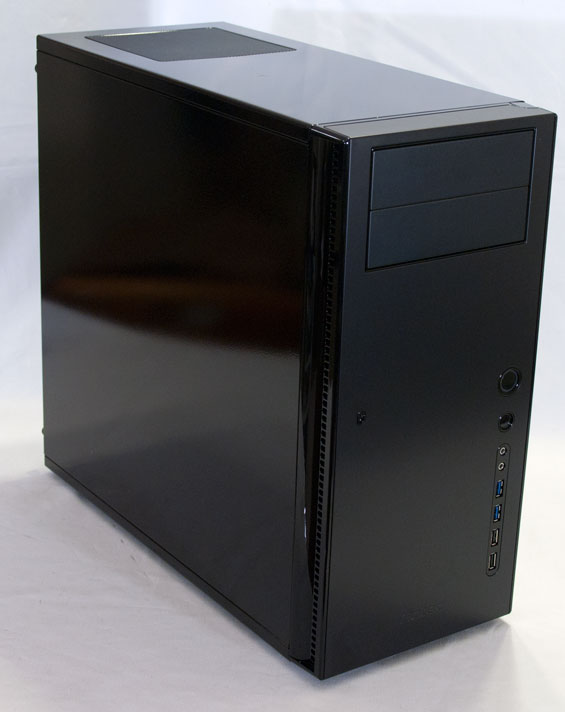
Externally the Solo II doesn't look like a massive evolution of the previous generation of Solo cases (which Antec considers part of their Sonata family of enclosures). That's not really an issue: while the appearances of Antec's gaming enclosures may be the subject of some debate, the Sonata line has always been attractive and understated without looking particularly chintzy or cheap. But looks can be deceiving, and the inside of the Solo II looks less like a traditional enclosure and more like a laboratory where Antec's engineers have begun experimenting with new (and old) approaches to case design.
| Antec Solo II Specifications | ||
| Motherboard Form Factor | ATX, Micro ATX, Mini ITX | |
| Drive Bays | External | 2x 5.25" |
| Internal | 3x 3.5"/2.5" or 2x 3.5" with suspension mounting; 1x 2.5" | |
| Cooling | Front | 2x 120mm intake fan mounts |
| Rear | 1x 120mm Antec TrueQuiet exhaust fan | |
| Top | - | |
| Side | - | |
| Bottom | - | |
| Expansion Slots | 7 | |
| Front I/O Port | 2x USB 2.0, 2x USB 3.0, mic and headphone jacks | |
| Top I/O Port | - | |
| Power Supply Size | ATX | |
| Clearance | 15" (Expansion Cards), 180mm (CPU HSF), 240mm (PSU) | |
| Weight | 20.2 lbs. (9.1 kg) | |
| Dimensions | 17.3" x 8.1" x 18.5" (440mm x 205mm x 470mm) | |
| Price | $129 MSRP | |
What isn't mentioned in the spec sheet is that Antec has also included soundproofing on the side panels, soundproofing that would've helped the Sonata IV perform better acoustically. There are thin sheets of polycarbonate attached to the insides of the top and side panels in a way that doesn't add heft or thickness but can introduce a notable improvement in noise.
In and Around the Antec Solo II
Antec has a wonderful tendency to keep most of their enclosures looking fairly classy and understated. Aesthetics have proven time and time again to be a major sticking point with many of you in our readership and it's understandable. For my personal system I had to choose between Thermaltake's Level 10 GT and SilverStone's FT02; the Level 10 GT may have slightly better thermals, but the FT02 is, at least in my eyes, much nicer to look at.
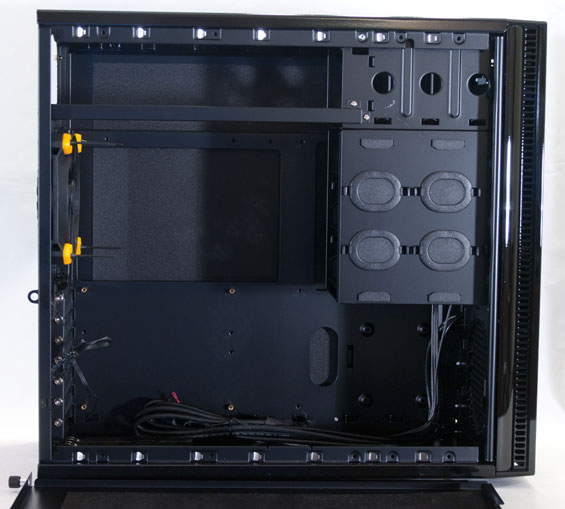
The rest of the enclosure is extremely spare, although the first sign of change is a vent at the top of the enclosure. Instead of using the power supply's bottom-mounted fan as an additional exhaust (as seen in older ATX case designs), Antec quietly suggests inverting the power supply and cooling it separately. The benefit to this design is that it takes the power supply's cooling out of the equation for the rest of the case. Though mounting the PSU to the top of an enclosure has fallen increasingly out of vogue, SilverStone's TJ-08E got a lot of mileage out of this design choice, as it allows you to mount the motherboard lower in the enclosure; the optical drive bays hang out in roughly the same space as the power supply, allowing for an intake directly in front of the CPU cooler.
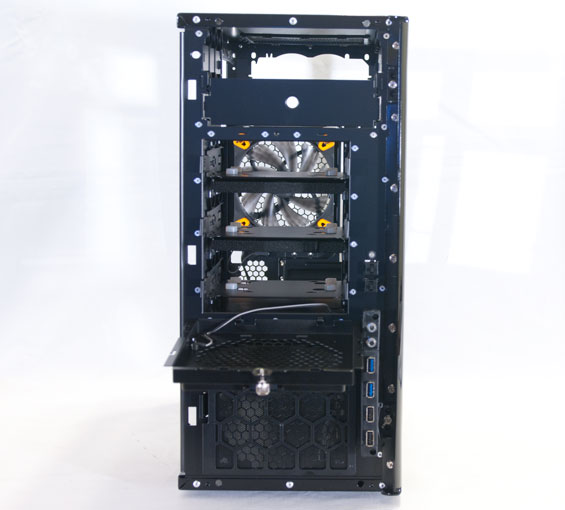
If you take a look at the back, you'll see everything is business as usual, but Antec has swapped out their traditional TriCool fan in favor of their new "TrueQuiet" fan. The TrueQuiet has a fan speed switch mounted just below it that can be set to either low or high. We're down one setting from the TriCool but somehow I just know we'll manage.
When you open the Solo II is where things start to get a little bit wild. One of the first major changes is that there's a small dedicated space behind the motherboard tray, something sorely lacking from the Sonata IV. It's a very small space, but Antec has still essentially allocated space for cable management. There are also cutouts in the motherboard tray both for mounting cooling and routing cables. Finally, there's clean space able to accommodate large video cards. Everything is mostly cordoned off and orderly.
The drive cage is an odd duck, though. Antec includes three drive sleds and two "suspension" mounts, and I have to be honest, I'm just not a fan of the suspension mounts. With the drive sleds in there (complete with sound-reducing silicon grommets) I have to wonder why these mounts were included at all; removing them could've snagged us space for an additional drive sled, bringing us up to a healthy four instead of the three we have. Behind the drive cage is the reason why it's not a lateral design: there are four sets of hooks designed to minimize cable clutter.
Assembling the Antec Solo II
While Antec has made a lot of strides in at least trying to make the Solo II easy to assemble, I'm not going to lie: I was pretty much dreading actually putting it together once I opened it up. Difficult assembly doesn't necessarily a bad case make (Ed: Says Yoda?); SilverStone produces some incredible cases, but half of the time you don't build them, you solve them.
Ordinarily I'd start by mounting the motherboard, but in the Solo II the absolute first thing you should install is the power supply. SilverStone's Temjin TJ08-E wasn't exactly easy to build either (top-mounted PSUs just seem to be problematic this way), but heaven help you if you ever need to replace your PSU once you've built a system inside the Solo II because you're just not going to be able to fit it around your heatsink. Thankfully the power supply went in alright, and Antec preinstalls most of the mounts for an ATX motherboard by default. The PSU and motherboard were pretty much the easy part.
Update: The Solo II ships with philips head screws attaching the PSU support bar on all sides, so you'll be able to remove the power supply without dismantling the rest of the enclosure.
Antec stashes the drive rails for the two 5.25" drive bays in the bottom of the case, a welcome change that keeps them readily available so that Antec's customer service doesn't have to gracefully send you free replacements (note: they've done that for me as a regular tax-paying ninja before I started doing these reviews). To install the 5.25" drive, along with anything using the 3.5" drive mounts, you'll need to remove the front panel. There are three levers on the inside of the enclosure that you press in, and the front panel actually swings outward on hinges. You're better off just lifting it off and removing it, though.
As much as I appreciate the rails for the optical drive, I've noticed they don't line up quite perfectly by default (you'll see in my completed build that the ODD is recessed), but the real question I have is why this isn't a tool-less installation to begin with. Virtually everybody else has graduated to a tool-less or near-tool-less mounting system for optical drives, but these rails are the exact same ones I installed on my friend's CD burner back when I assembled her AMD Athlon XP 2500+ machine. I wish that were an exaggeration. This needs to be updated desperately.
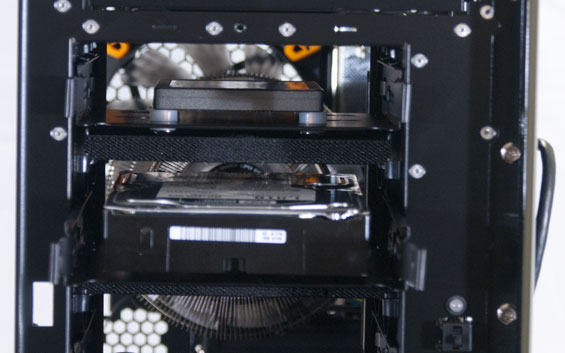
The press materials suggest hard drives are easy to install and upgrade, but don't you believe it. You have to remove the front panel, then unscrew a hinged ventilation grate (also capable of holding a 120mm intake fan) to get to the drive mounting system. From there you can either strap a 3.5" drive in with the suspension system (I'm not a fan), or you can remove the drive sleds and do it that way. I prefer the drive sleds as they include silicone grommets and can support both 3.5" drives and 2.5" drives. As a nice feature, you still use the grommets for mounting 2.5" drives, a reminder that 2.5" mechanical hard drives still exist (something other case manufacturers often forget), though we'd generally recommend 2.5" SSDs for desktop systems.
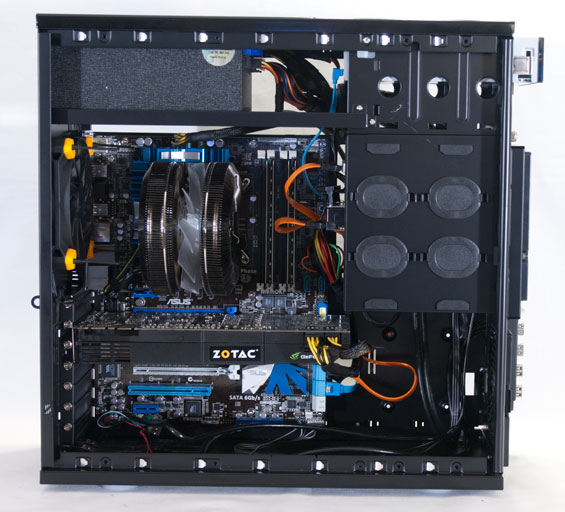
Finally, installing the video card was easy enough (as it usually is), but Antec uses old-fashioned screws for mounting instead of thumbscrews. Honestly I'm not sure I care that much either way; I'm terribly frail and generally just don't have the strength to twist thumbscrews unless I'm in a hurry, and I always wind up using a screwdriver anyhow. Cabling was a red nightmare, though, and again I have to stress: modular power supplies are your friend.
I'm keen to point out that SilverStone sent me a little dongle to try out and I've wound up using it in the last two case tests. This cable converts one SATA power cable into four in a neat line, and it is fantastic.
Testing Methodology
For testing ATX cases, we use the following standardized testbed in stock and overclocked configurations to get a feel for how well the case handles heat and noise.
| Full ATX Test Configuration | |
| CPU |
Intel Core i7-875K (95W TDP, tested at stock speed and overclocked to 3.8GHz @ 1.38V) |
| Motherboard | ASUS P7P55D-E Pro |
| Graphics Card | Zotac NVIDIA GeForce GTX 580 (244W TDP) |
| Memory | 2x2GB Crucial Ballistix Smart Tracer DDR3-1600 |
| Drives |
Kingston SSDNow V+ 100 64GB SSD Western Digital Caviar Black 1TB SATA 6Gbps Samsung 5.25" BD-ROM/DVDRW Drive |
| CPU Cooler | Zalman CNPS9900 MAX with Cooler Master ThermalFusion 400 |
| Power Supply | SilverStone Strider Gold 750W 80 Plus Gold |
A refresher on how we test:
Acoustic testing is standardized on a foot from the front of the case, using the Extech SL10 with an ambient noise floor of ~32dB. For reference, that's what my silent apartment measures with nothing running, testing acoustics in the dead of night (usually between 1am and 3am). A lot of us sit about a foot away from our computers, so this should be a fairly accurate representation of the kind of noise the case generates, and it's close enough to get noise levels that should register above ambient.
Thermal testing is run with the computer having idled at the desktop for fifteen minutes, and again with the computer running both Furmark (where applicable) and Prime95 (less one thread when a GPU is being used) for fifteen minutes. I've found that leaving one thread open in Prime95 allows the processor to heat up enough while making sure Furmark isn't CPU-limited. We're using the thermal diodes included with the hardware to keep everything standardized, and ambient testing temperature is always between 71F and 74F. Processor temperatures reported are the average of the CPU cores.
For more details on how we arrived at this testbed, you can check out our introductory passage in the review for the IN-WIN BUC.
Last but not least, we'd also like to thank the vendors who made our testbed possible:
Thank You!
We have some thanks in order before we press on:
- Thank you to Crucial for providing us with the Ballistix Smart Tracer memory we used to add memory thermals to our testing.
- Thank you to Zalman for providing us with the CNPS9900 MAX heatsink and fan unit we used.
- Thank you to Kingston for providing us with the SSDNow V+ 100 SSD.
- Thank you to CyberPower for providing us with the Western Digital Caviar Black hard drive, Intel Core i7-875K processor, ASUS P7P55D-E Pro motherboard, and Samsung BD-ROM/DVD+/-RW drive.
- And thank you to SilverStone for providing us with the power supply and SATA power cable.
Noise and Thermal Testing, Stock
Before we get into the hard numbers, I'm keen to point out that Antec has designed the Solo II with an emphasis on acoustics over thermal performance. This was true of Corsair's Obsidian 650D as well, and though I'm not personally a fan of design decisions that force those kinds of trade-offs, Antec wants to see the Solo II in businesses as much as in home offices, dens, and bedrooms. In other words, expect higher temperatures but hopefully noise levels will make up for the heat.
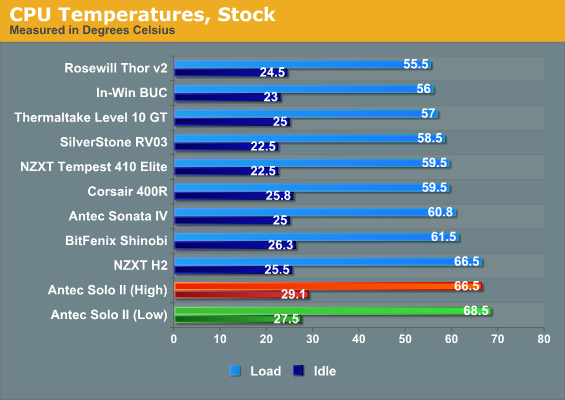
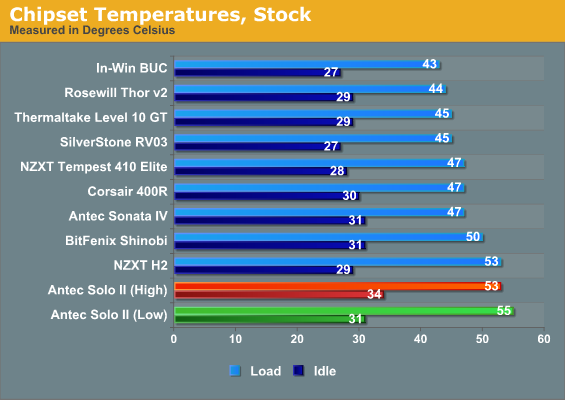



That preface is probably a good thing, because unfortunately the Solo II posts the worst thermals we've ever tested in an ATX enclosure. Antec includes two 120mm mounts for intake fans and judging from these temperatures, the Solo II probably should've been shipping with at least one of those mounts populated, if not both. Even the NZXT H2, whose intake fans are starved for air by the closed front door of the enclosure, posts better thermal results.

At least on the flipside, the Solo II also posts the best acoustic results we've yet seen. We can gripe about a trade-off being made, but at least there's a clear benefit to it. Note how much quieter it runs compared to the under-engineered Antec Sonata IV, too. The only cases that offer a better compromise of noise and thermal performance are either huge and/or out of place in an office, though this is one situation where BitFenix's Shinobi might be a very strong alternative. If you're a business running without dedicated graphics, something like the Solo II will work great, but gamers will benefit from additional cooling.
Noise and Thermal Testing, Overclocked
Given the high temperatures of the Antec Solo II in just our stock testing, it's with some trepidation that I even began testing it overclocked. For what it's worth, the Solo II stayed quiet through testing (although the character of the noise was a bit higher pitched than I'd prefer). Unfortunately you could also touch the side panels of the case and really feel the heat radiating off of it.
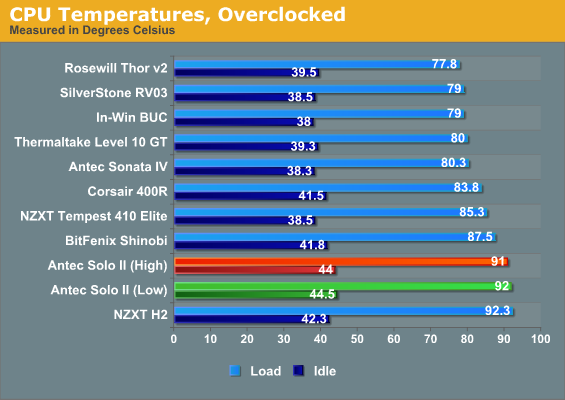
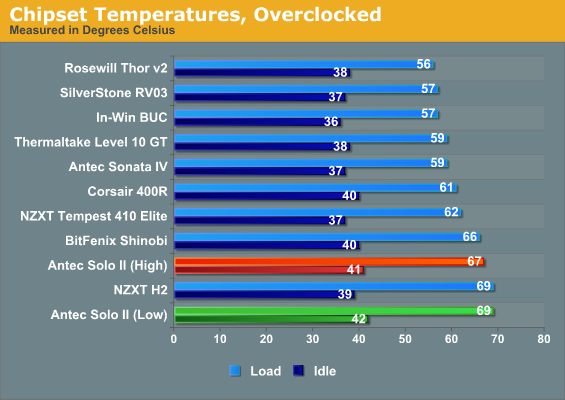
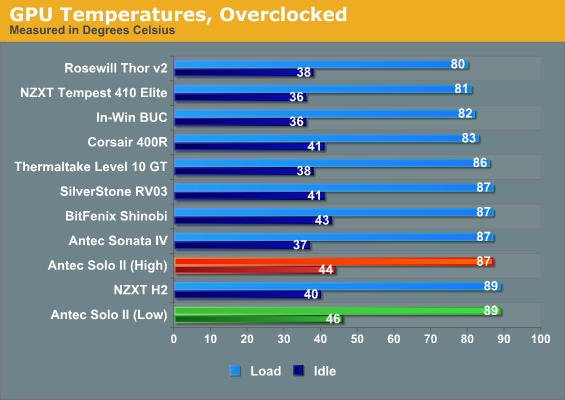
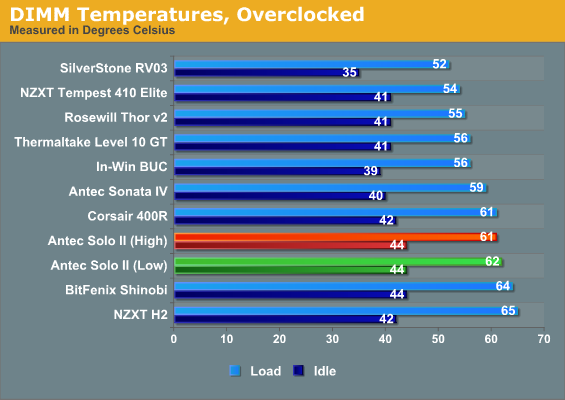
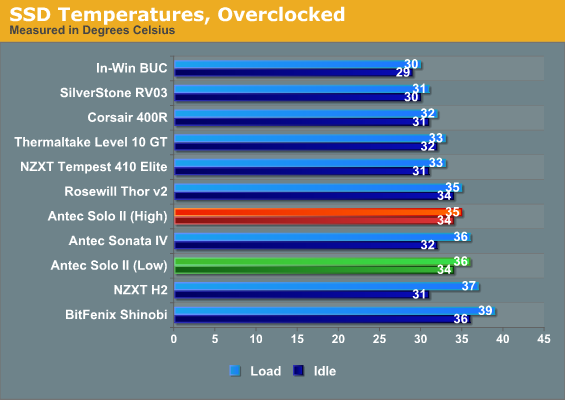
Once we get into overclocked testing, the Solo II's design actually starts to feel a little more balanced and it begins to separate itself from the NZXT H2. Unfortunately, the BitFenix Shinobi continues to be a thorn in its side as a reasonable alternative in terms of both aesthetics and the mixture of thermal and acoustic performance.
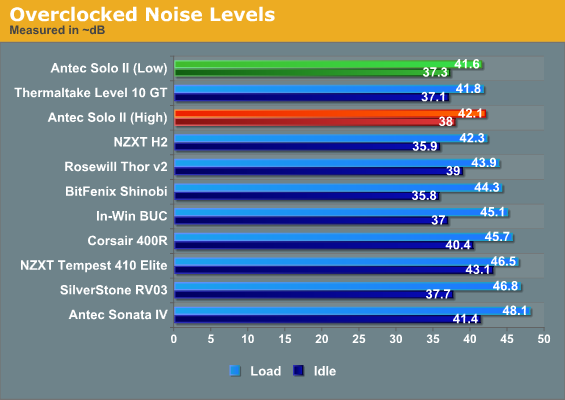
It may be cooking the testbed, but the Solo II does continue to do so with a minimal amount of noise. The acoustic insulation in the enclosure pays off in spades; only the giant (and twice as expensive) Thermaltake Level 10 GT can really compete.
Conclusion: Silence at Any Cost
The takeaway from all of our testing of the Antec Solo II is a pretty simple one: if you prioritize silent running above all else, your choice is fairly clear. For the office environments Antec hopes to cater to, the Solo II is going to be a stellar enclosure with its understated appearance and equally unobtrusive acoustics. It's simply one of the quietest cases we've ever tested, if not the quietest.
Unfortunately, Antec also wants to cater to enthusiasts with the Solo II, and in that respect it's just not competitive. In order for Antec's offering to compete with cases like the much less expensive BitFenix Shinobi or Corsair Carbide 400R, they really needed to at least include one intake fan, and preferrably two. I have trouble fathoming a situation in which building an enthusiast-class machine in the Solo II would be wise. If you want a quiet machine for moderate gaming, then yes, it'd probably be adequate. But just because you can fit an AMD Radeon HD 6990 or two into the Solo II doesn't mean you should.
I also think Antec is having the same problem with the Solo II they had with the Sonata IV: it's priced right out of competition. At $129 it just doesn't make sense. Is BitFenix's Shinobi a little smaller and chintzier-looking? Sure. But it's also a lot less expensive and capable of offering only slightly louder acoustics in exchange for much better thermal performance (which is probably what would happen if you added a 120mm intake to the Solo II). If you're willing to switch to Micro-ATX, then SilverStone's $99 Temjin TJ08-E will blow the pants off of the Solo II. I recently assembled a system for a sound engineer in the TJ08-E; get even an inexpensive tower cooler in that case (Cooler Master's Hyper 212 Plus is my personal favorite) and marvel at how quietly and coolly it actually runs. That's an enclosure that's arguably as attractive as the Solo II, but both smaller and more efficient.
Antec's engineers have a lot of good ideas in the Solo II, but there's still a ways to go. The suspension mounting system should probably just be ditched entirely (personal preference) in favor of four drive sleds, and the case desperately needs intake fans. This is a very quiet case with excellent soundproofing, but adding intakes might actually improve acoustic performance under load as the processor's fan will have much less work to do. I'd also like to see just a little more room behind the motherboard tray. Finally, that pricetag really needs to go down. $129 is unreasonable for what you get when other vendors are willing to give you more for less.
I'm a huge Antec fan—always have been, always will be. The Solo II is definitely a much stronger step forward compared to the middling Sonata IV, and their engineers seem to be on the right track. But the enclosure market is extremely competitive these days, and this design still has a ways to go before it can earn a full-blooded recommendation. If you're interested in silence above all else, it doesn't get much quieter than the Solo II, but I'm not sure it's worth the costs.



















